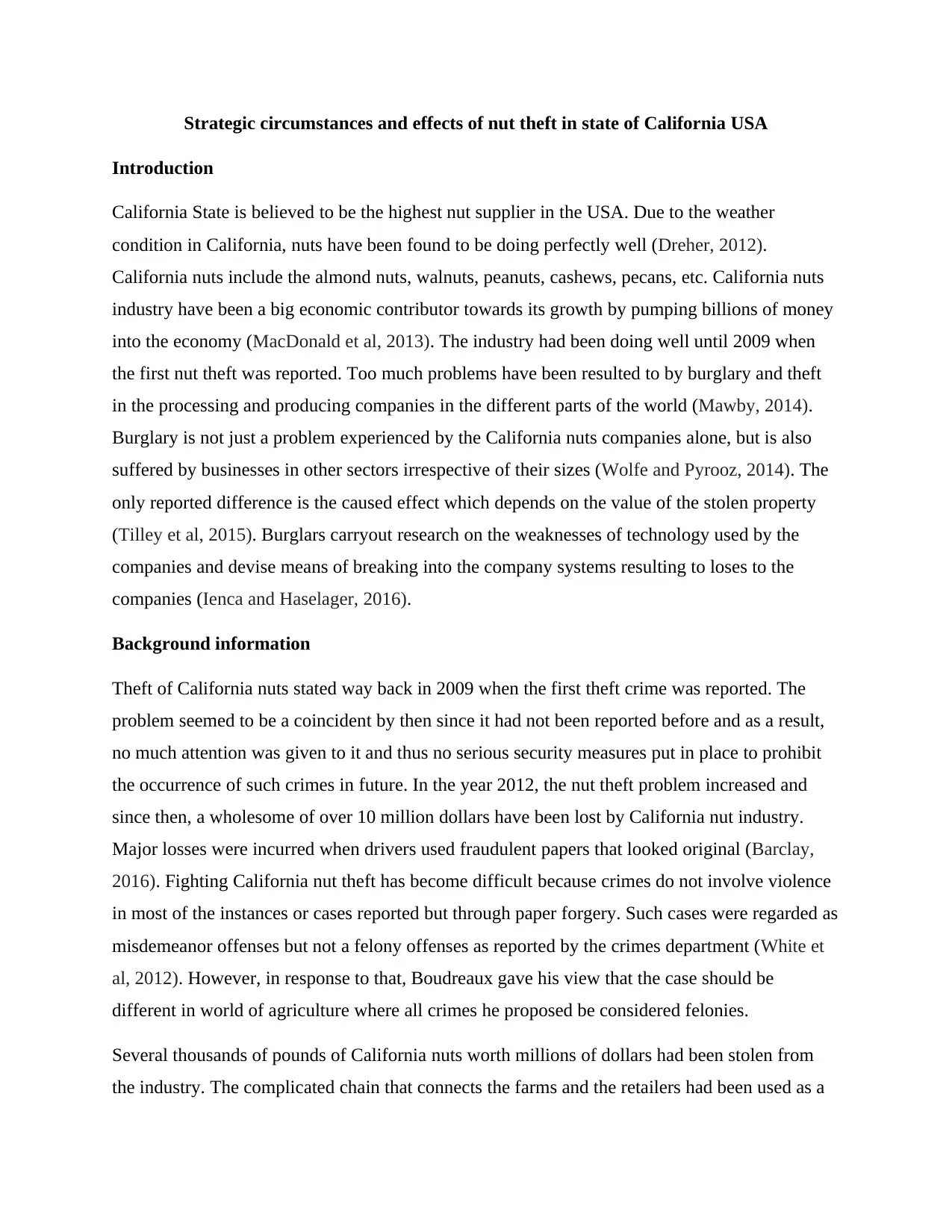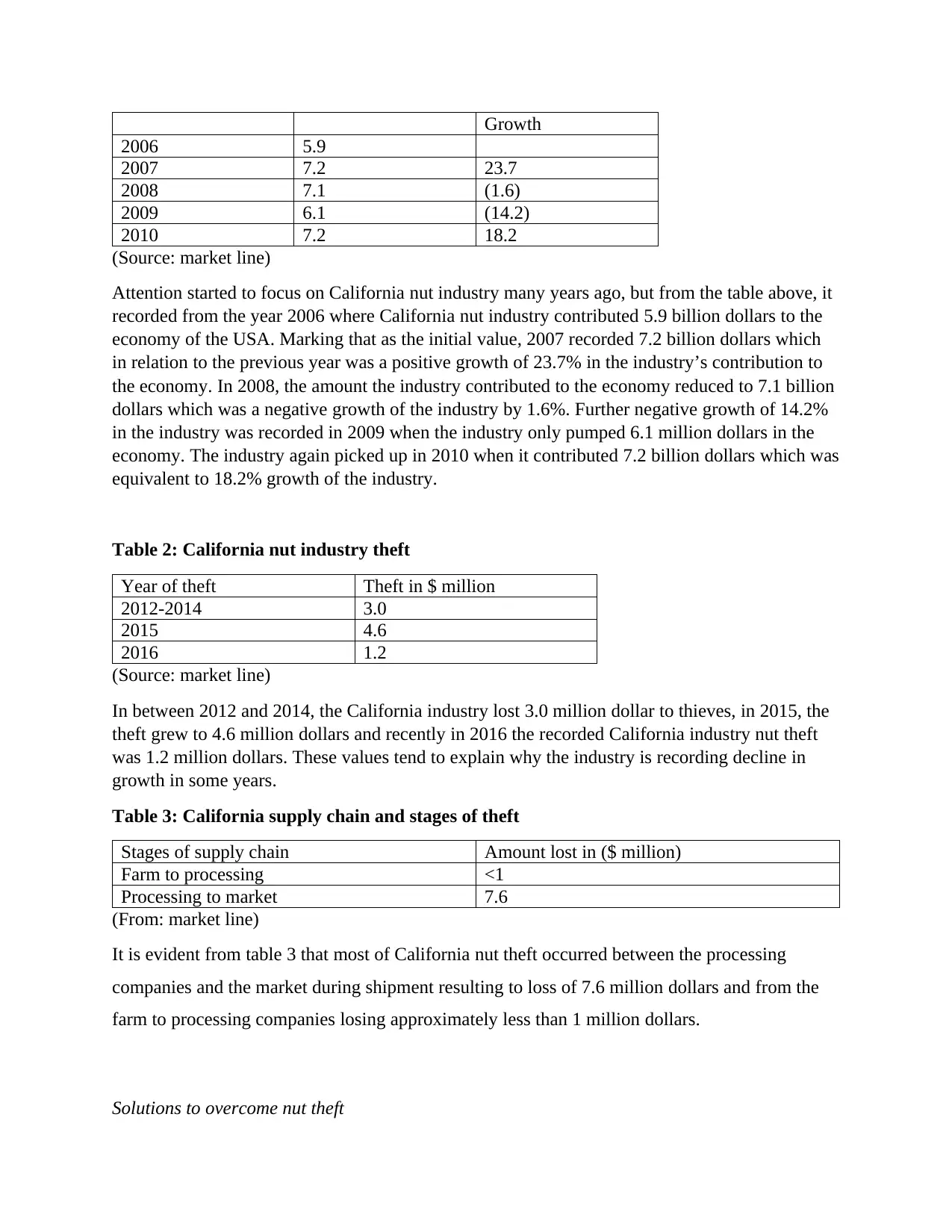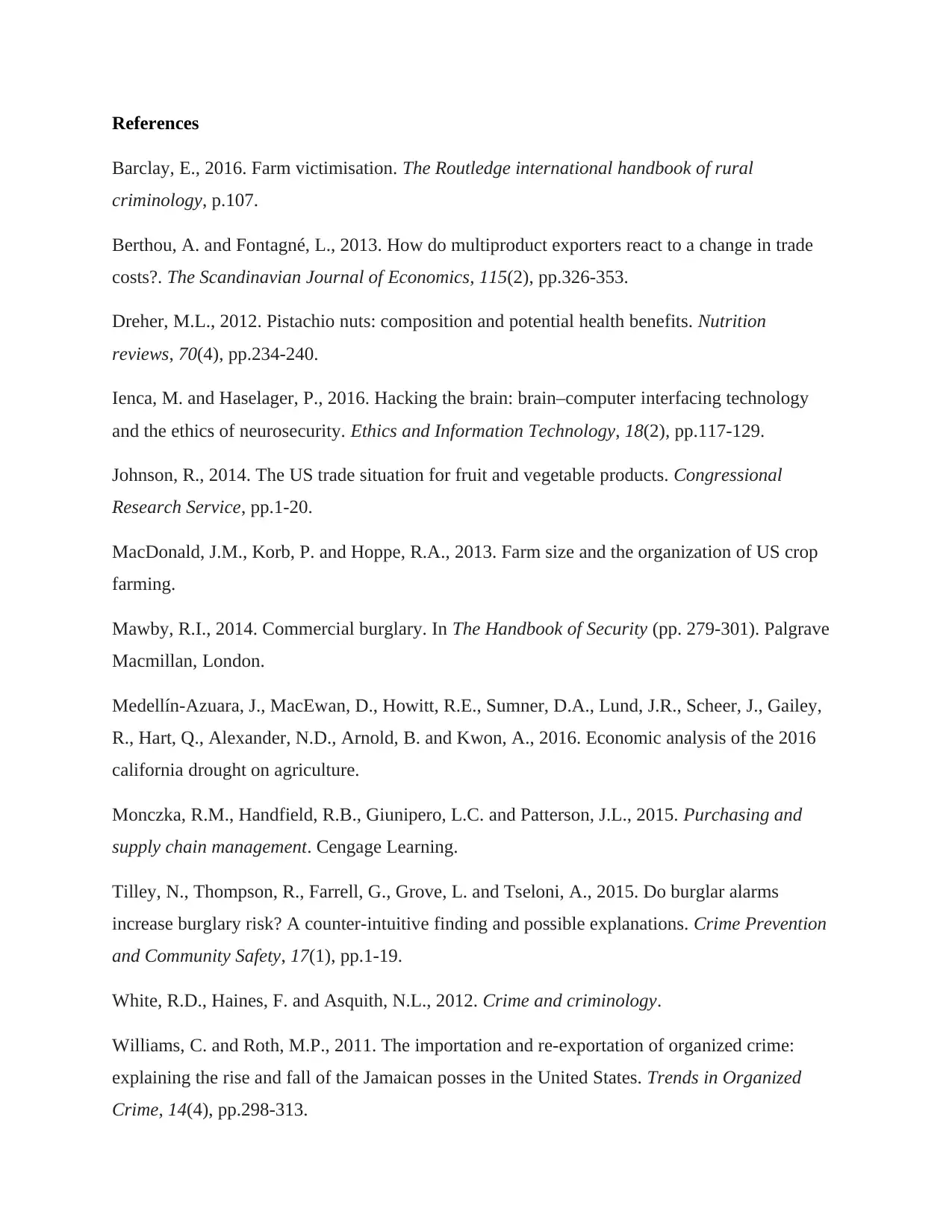Report on Strategic Circumstances & Effects of Nut Theft in California
VerifiedAdded on 2023/06/12
|7
|2226
|111
Report
AI Summary
This report examines the strategic circumstances and economic effects of nut theft in California, a major nut supplier in the USA. The California nut industry, including almonds, walnuts, and pecans, contributes billions to the US economy but has faced increasing theft since 2009, resulting in over $10 million in losses. Thefts often occur during shipment using forged documents, exploiting vulnerabilities in the supply chain from farms to processing companies to markets. Quantitative analysis reveals the industry's economic contribution and the financial impact of theft incidents between 2012 and 2016. Solutions proposed include enhanced security measures like driver verification, CCTV installation on farms, increased roadblocks, stricter agricultural laws, and trackable serial tags. The report concludes that addressing these loopholes is crucial to protect the industry's economic contributions and mitigate further losses. Desklib provides access to similar reports and assignments for students.

Strategic circumstances and effects of nut theft in state of California USA
Introduction
California State is believed to be the highest nut supplier in the USA. Due to the weather
condition in California, nuts have been found to be doing perfectly well (Dreher, 2012).
California nuts include the almond nuts, walnuts, peanuts, cashews, pecans, etc. California nuts
industry have been a big economic contributor towards its growth by pumping billions of money
into the economy (MacDonald et al, 2013). The industry had been doing well until 2009 when
the first nut theft was reported. Too much problems have been resulted to by burglary and theft
in the processing and producing companies in the different parts of the world (Mawby, 2014).
Burglary is not just a problem experienced by the California nuts companies alone, but is also
suffered by businesses in other sectors irrespective of their sizes (Wolfe and Pyrooz, 2014). The
only reported difference is the caused effect which depends on the value of the stolen property
(Tilley et al, 2015). Burglars carryout research on the weaknesses of technology used by the
companies and devise means of breaking into the company systems resulting to loses to the
companies (Ienca and Haselager, 2016).
Background information
Theft of California nuts stated way back in 2009 when the first theft crime was reported. The
problem seemed to be a coincident by then since it had not been reported before and as a result,
no much attention was given to it and thus no serious security measures put in place to prohibit
the occurrence of such crimes in future. In the year 2012, the nut theft problem increased and
since then, a wholesome of over 10 million dollars have been lost by California nut industry.
Major losses were incurred when drivers used fraudulent papers that looked original (Barclay,
2016). Fighting California nut theft has become difficult because crimes do not involve violence
in most of the instances or cases reported but through paper forgery. Such cases were regarded as
misdemeanor offenses but not a felony offenses as reported by the crimes department (White et
al, 2012). However, in response to that, Boudreaux gave his view that the case should be
different in world of agriculture where all crimes he proposed be considered felonies.
Several thousands of pounds of California nuts worth millions of dollars had been stolen from
the industry. The complicated chain that connects the farms and the retailers had been used as a
Introduction
California State is believed to be the highest nut supplier in the USA. Due to the weather
condition in California, nuts have been found to be doing perfectly well (Dreher, 2012).
California nuts include the almond nuts, walnuts, peanuts, cashews, pecans, etc. California nuts
industry have been a big economic contributor towards its growth by pumping billions of money
into the economy (MacDonald et al, 2013). The industry had been doing well until 2009 when
the first nut theft was reported. Too much problems have been resulted to by burglary and theft
in the processing and producing companies in the different parts of the world (Mawby, 2014).
Burglary is not just a problem experienced by the California nuts companies alone, but is also
suffered by businesses in other sectors irrespective of their sizes (Wolfe and Pyrooz, 2014). The
only reported difference is the caused effect which depends on the value of the stolen property
(Tilley et al, 2015). Burglars carryout research on the weaknesses of technology used by the
companies and devise means of breaking into the company systems resulting to loses to the
companies (Ienca and Haselager, 2016).
Background information
Theft of California nuts stated way back in 2009 when the first theft crime was reported. The
problem seemed to be a coincident by then since it had not been reported before and as a result,
no much attention was given to it and thus no serious security measures put in place to prohibit
the occurrence of such crimes in future. In the year 2012, the nut theft problem increased and
since then, a wholesome of over 10 million dollars have been lost by California nut industry.
Major losses were incurred when drivers used fraudulent papers that looked original (Barclay,
2016). Fighting California nut theft has become difficult because crimes do not involve violence
in most of the instances or cases reported but through paper forgery. Such cases were regarded as
misdemeanor offenses but not a felony offenses as reported by the crimes department (White et
al, 2012). However, in response to that, Boudreaux gave his view that the case should be
different in world of agriculture where all crimes he proposed be considered felonies.
Several thousands of pounds of California nuts worth millions of dollars had been stolen from
the industry. The complicated chain that connects the farms and the retailers had been used as a
Paraphrase This Document
Need a fresh take? Get an instant paraphrase of this document with our AI Paraphraser

leeway by thieves to have made away with approximately 10 million dollars of nuts, this came as
a shocker to the law enforcers and the farmers (Medellín-Azuara et al, 2016). The rise in the theft
of California nuts was as a result of the replacement of electronics by food and beverages in the
highly stolen goods in the United States. The prices of nuts are high and expensive and this make
thieves to focus on fewer burglary of bigger values (Williams and Roth, 2011). Technology has
as well provided some loopholes for thieves who steal from California nut industry as thieves use
advanced technology to have access to legitimate transportation documents. Spread of black
markets is also another issue of concern that encouraged California nut theft.
Figure 1: Supply chain for California nut industry
From the above chain; figure1, preparations of nuts starts directly from the farm where thousands
of hectares (i.e. about 40,000 h) are set aside for nut farming activities. Upon their readiness in
the farm for harvest, they are harvested and loaded in the shipping trucks where nuts are taken to
the companies for processing. Transportation sector is important when it comes to getting raw
materials from their locations to the companies for use in the production of other useful products
Nut Farm California
Companies
(California industry)
Nut market
(Local and International)
Nut Shipment
(truckloads and others)
a shocker to the law enforcers and the farmers (Medellín-Azuara et al, 2016). The rise in the theft
of California nuts was as a result of the replacement of electronics by food and beverages in the
highly stolen goods in the United States. The prices of nuts are high and expensive and this make
thieves to focus on fewer burglary of bigger values (Williams and Roth, 2011). Technology has
as well provided some loopholes for thieves who steal from California nut industry as thieves use
advanced technology to have access to legitimate transportation documents. Spread of black
markets is also another issue of concern that encouraged California nut theft.
Figure 1: Supply chain for California nut industry
From the above chain; figure1, preparations of nuts starts directly from the farm where thousands
of hectares (i.e. about 40,000 h) are set aside for nut farming activities. Upon their readiness in
the farm for harvest, they are harvested and loaded in the shipping trucks where nuts are taken to
the companies for processing. Transportation sector is important when it comes to getting raw
materials from their locations to the companies for use in the production of other useful products
Nut Farm California
Companies
(California industry)
Nut market
(Local and International)
Nut Shipment
(truckloads and others)

(Monczka et al., 2015). Nuts upon reaching the processing companies, they are taken into the
processing procedures where then finished products are resulted into. Various processing stages
are followed to the latter till the intended products are obtained. The processing outputs are
packed into different packages depending on the market requirement (Johnson, 2014). The cost
incurred on shipment depends on the destination of the products where in this case local
shipment might be less expensive than international shipment (Berthou and Fontagné, 2013).
Most of the losses suffered by California nut industry as a result of theft were at the time of
shipment. The department of transportation database reported that the industry lose about over
$500, 000 per load of the processed products by the companies. Thieves get their ways to the
California nut companies by forging trucking company details and go away with the goods. As a
result, many companies had fallen victims of the circumstance of nut theft and lose huge loads of
products as thieves used legitimate shipment documents, this was reported by Horizon Nut
Company and Setton Farms. Not limited to those two companies, other companies such as
Hughson Nut Company, Almond processors, Walnut processors and many others had reported
similar incidents in the past few years.
Reports given by Butte County Sherriff’s Department officer, Matt Calkins, stated that high
value of loads are taken in the radar of the thieves and they then process legitimate shipment
documents through dubious means making them appear as if from transportation industry and
making away with goods. Thieves had access to these legitimate transportation documents from
the internet. Chief executive officer of Transit Risk Management in Long Beach Calif, Sam
Wadhwani reported that burglary are high in some specific days of the week i.e. before and
immediately after the weekends then drive away with the goods. Thousands of pounds of stolen
California nut products are transported to the international markets where they are sold. Security
was agreed to be hiked where the number of roadblocks was proposed to be increased to offer
more check points of the nut truckloads.
Quantitative analysis of the case
Table 1: Value in US dollars of California nut industry
Year of production Amount in $ Billion Percentage (%)
processing procedures where then finished products are resulted into. Various processing stages
are followed to the latter till the intended products are obtained. The processing outputs are
packed into different packages depending on the market requirement (Johnson, 2014). The cost
incurred on shipment depends on the destination of the products where in this case local
shipment might be less expensive than international shipment (Berthou and Fontagné, 2013).
Most of the losses suffered by California nut industry as a result of theft were at the time of
shipment. The department of transportation database reported that the industry lose about over
$500, 000 per load of the processed products by the companies. Thieves get their ways to the
California nut companies by forging trucking company details and go away with the goods. As a
result, many companies had fallen victims of the circumstance of nut theft and lose huge loads of
products as thieves used legitimate shipment documents, this was reported by Horizon Nut
Company and Setton Farms. Not limited to those two companies, other companies such as
Hughson Nut Company, Almond processors, Walnut processors and many others had reported
similar incidents in the past few years.
Reports given by Butte County Sherriff’s Department officer, Matt Calkins, stated that high
value of loads are taken in the radar of the thieves and they then process legitimate shipment
documents through dubious means making them appear as if from transportation industry and
making away with goods. Thieves had access to these legitimate transportation documents from
the internet. Chief executive officer of Transit Risk Management in Long Beach Calif, Sam
Wadhwani reported that burglary are high in some specific days of the week i.e. before and
immediately after the weekends then drive away with the goods. Thousands of pounds of stolen
California nut products are transported to the international markets where they are sold. Security
was agreed to be hiked where the number of roadblocks was proposed to be increased to offer
more check points of the nut truckloads.
Quantitative analysis of the case
Table 1: Value in US dollars of California nut industry
Year of production Amount in $ Billion Percentage (%)
⊘ This is a preview!⊘
Do you want full access?
Subscribe today to unlock all pages.

Trusted by 1+ million students worldwide

Growth
2006 5.9
2007 7.2 23.7
2008 7.1 (1.6)
2009 6.1 (14.2)
2010 7.2 18.2
(Source: market line)
Attention started to focus on California nut industry many years ago, but from the table above, it
recorded from the year 2006 where California nut industry contributed 5.9 billion dollars to the
economy of the USA. Marking that as the initial value, 2007 recorded 7.2 billion dollars which
in relation to the previous year was a positive growth of 23.7% in the industry’s contribution to
the economy. In 2008, the amount the industry contributed to the economy reduced to 7.1 billion
dollars which was a negative growth of the industry by 1.6%. Further negative growth of 14.2%
in the industry was recorded in 2009 when the industry only pumped 6.1 million dollars in the
economy. The industry again picked up in 2010 when it contributed 7.2 billion dollars which was
equivalent to 18.2% growth of the industry.
Table 2: California nut industry theft
Year of theft Theft in $ million
2012-2014 3.0
2015 4.6
2016 1.2
(Source: market line)
In between 2012 and 2014, the California industry lost 3.0 million dollar to thieves, in 2015, the
theft grew to 4.6 million dollars and recently in 2016 the recorded California industry nut theft
was 1.2 million dollars. These values tend to explain why the industry is recording decline in
growth in some years.
Table 3: California supply chain and stages of theft
Stages of supply chain Amount lost in ($ million)
Farm to processing <1
Processing to market 7.6
(From: market line)
It is evident from table 3 that most of California nut theft occurred between the processing
companies and the market during shipment resulting to loss of 7.6 million dollars and from the
farm to processing companies losing approximately less than 1 million dollars.
Solutions to overcome nut theft
2006 5.9
2007 7.2 23.7
2008 7.1 (1.6)
2009 6.1 (14.2)
2010 7.2 18.2
(Source: market line)
Attention started to focus on California nut industry many years ago, but from the table above, it
recorded from the year 2006 where California nut industry contributed 5.9 billion dollars to the
economy of the USA. Marking that as the initial value, 2007 recorded 7.2 billion dollars which
in relation to the previous year was a positive growth of 23.7% in the industry’s contribution to
the economy. In 2008, the amount the industry contributed to the economy reduced to 7.1 billion
dollars which was a negative growth of the industry by 1.6%. Further negative growth of 14.2%
in the industry was recorded in 2009 when the industry only pumped 6.1 million dollars in the
economy. The industry again picked up in 2010 when it contributed 7.2 billion dollars which was
equivalent to 18.2% growth of the industry.
Table 2: California nut industry theft
Year of theft Theft in $ million
2012-2014 3.0
2015 4.6
2016 1.2
(Source: market line)
In between 2012 and 2014, the California industry lost 3.0 million dollar to thieves, in 2015, the
theft grew to 4.6 million dollars and recently in 2016 the recorded California industry nut theft
was 1.2 million dollars. These values tend to explain why the industry is recording decline in
growth in some years.
Table 3: California supply chain and stages of theft
Stages of supply chain Amount lost in ($ million)
Farm to processing <1
Processing to market 7.6
(From: market line)
It is evident from table 3 that most of California nut theft occurred between the processing
companies and the market during shipment resulting to loss of 7.6 million dollars and from the
farm to processing companies losing approximately less than 1 million dollars.
Solutions to overcome nut theft
Paraphrase This Document
Need a fresh take? Get an instant paraphrase of this document with our AI Paraphraser

Solutions that have been identified are taking records of the truck drivers’ licenses and also using
fingerprint scanners to record their images and their true identities. Furthermore, drivers are
supposed to be subjected into thorough questioning of the destinations of truckloads. Employing
these by the nut companies in California nut industry will help reduce the recurrence of theft
activities in the industry. When nut are still in the farm, since theft of nuts starts from the farm,
CCTV cameras are supposed to be installed in the farms to help monitor the farms. Employing
this idea will help security officers in monitoring nut farms and keeping them theft free. Also,
number of roadblocks are supposed to be increased to increase nut truckloads checkpoints. Law
makers are supposed to make tight agricultural laws to provide harsh punishment to thieves
caught. Trackable serial tags are supposed to be introduced in nut products to make tracking easy
should thieves drive away with them in the truckloads.
Summary of the findings
Findings from this report discovered that huge loss have been experienced and suffered by
California nut industry. California nut are at risk of theft at all stages right from the farm all
through to the final market resulting to loss of over 7.6 million dollars. The spread of black
markets locally and internationally was one of the factors that had kept burglary alive in the
recent past. A number of strategic plans were brought forth were as discussed above.
Conclusion
In conclusion, great loss had been suffered by California nut industry, being that the industry
contributes to the US economy, the entire country’s economy is hurt. The highest percentage of
California nut companies have suffered losses from theft. Major loopholes that have been
identified in this report need to be prioritized.
fingerprint scanners to record their images and their true identities. Furthermore, drivers are
supposed to be subjected into thorough questioning of the destinations of truckloads. Employing
these by the nut companies in California nut industry will help reduce the recurrence of theft
activities in the industry. When nut are still in the farm, since theft of nuts starts from the farm,
CCTV cameras are supposed to be installed in the farms to help monitor the farms. Employing
this idea will help security officers in monitoring nut farms and keeping them theft free. Also,
number of roadblocks are supposed to be increased to increase nut truckloads checkpoints. Law
makers are supposed to make tight agricultural laws to provide harsh punishment to thieves
caught. Trackable serial tags are supposed to be introduced in nut products to make tracking easy
should thieves drive away with them in the truckloads.
Summary of the findings
Findings from this report discovered that huge loss have been experienced and suffered by
California nut industry. California nut are at risk of theft at all stages right from the farm all
through to the final market resulting to loss of over 7.6 million dollars. The spread of black
markets locally and internationally was one of the factors that had kept burglary alive in the
recent past. A number of strategic plans were brought forth were as discussed above.
Conclusion
In conclusion, great loss had been suffered by California nut industry, being that the industry
contributes to the US economy, the entire country’s economy is hurt. The highest percentage of
California nut companies have suffered losses from theft. Major loopholes that have been
identified in this report need to be prioritized.

References
Barclay, E., 2016. Farm victimisation. The Routledge international handbook of rural
criminology, p.107.
Berthou, A. and Fontagné, L., 2013. How do multiproduct exporters react to a change in trade
costs?. The Scandinavian Journal of Economics, 115(2), pp.326-353.
Dreher, M.L., 2012. Pistachio nuts: composition and potential health benefits. Nutrition
reviews, 70(4), pp.234-240.
Ienca, M. and Haselager, P., 2016. Hacking the brain: brain–computer interfacing technology
and the ethics of neurosecurity. Ethics and Information Technology, 18(2), pp.117-129.
Johnson, R., 2014. The US trade situation for fruit and vegetable products. Congressional
Research Service, pp.1-20.
MacDonald, J.M., Korb, P. and Hoppe, R.A., 2013. Farm size and the organization of US crop
farming.
Mawby, R.I., 2014. Commercial burglary. In The Handbook of Security (pp. 279-301). Palgrave
Macmillan, London.
Medellín-Azuara, J., MacEwan, D., Howitt, R.E., Sumner, D.A., Lund, J.R., Scheer, J., Gailey,
R., Hart, Q., Alexander, N.D., Arnold, B. and Kwon, A., 2016. Economic analysis of the 2016
california drought on agriculture.
Monczka, R.M., Handfield, R.B., Giunipero, L.C. and Patterson, J.L., 2015. Purchasing and
supply chain management. Cengage Learning.
Tilley, N., Thompson, R., Farrell, G., Grove, L. and Tseloni, A., 2015. Do burglar alarms
increase burglary risk? A counter-intuitive finding and possible explanations. Crime Prevention
and Community Safety, 17(1), pp.1-19.
White, R.D., Haines, F. and Asquith, N.L., 2012. Crime and criminology.
Williams, C. and Roth, M.P., 2011. The importation and re-exportation of organized crime:
explaining the rise and fall of the Jamaican posses in the United States. Trends in Organized
Crime, 14(4), pp.298-313.
Barclay, E., 2016. Farm victimisation. The Routledge international handbook of rural
criminology, p.107.
Berthou, A. and Fontagné, L., 2013. How do multiproduct exporters react to a change in trade
costs?. The Scandinavian Journal of Economics, 115(2), pp.326-353.
Dreher, M.L., 2012. Pistachio nuts: composition and potential health benefits. Nutrition
reviews, 70(4), pp.234-240.
Ienca, M. and Haselager, P., 2016. Hacking the brain: brain–computer interfacing technology
and the ethics of neurosecurity. Ethics and Information Technology, 18(2), pp.117-129.
Johnson, R., 2014. The US trade situation for fruit and vegetable products. Congressional
Research Service, pp.1-20.
MacDonald, J.M., Korb, P. and Hoppe, R.A., 2013. Farm size and the organization of US crop
farming.
Mawby, R.I., 2014. Commercial burglary. In The Handbook of Security (pp. 279-301). Palgrave
Macmillan, London.
Medellín-Azuara, J., MacEwan, D., Howitt, R.E., Sumner, D.A., Lund, J.R., Scheer, J., Gailey,
R., Hart, Q., Alexander, N.D., Arnold, B. and Kwon, A., 2016. Economic analysis of the 2016
california drought on agriculture.
Monczka, R.M., Handfield, R.B., Giunipero, L.C. and Patterson, J.L., 2015. Purchasing and
supply chain management. Cengage Learning.
Tilley, N., Thompson, R., Farrell, G., Grove, L. and Tseloni, A., 2015. Do burglar alarms
increase burglary risk? A counter-intuitive finding and possible explanations. Crime Prevention
and Community Safety, 17(1), pp.1-19.
White, R.D., Haines, F. and Asquith, N.L., 2012. Crime and criminology.
Williams, C. and Roth, M.P., 2011. The importation and re-exportation of organized crime:
explaining the rise and fall of the Jamaican posses in the United States. Trends in Organized
Crime, 14(4), pp.298-313.
⊘ This is a preview!⊘
Do you want full access?
Subscribe today to unlock all pages.

Trusted by 1+ million students worldwide

Wolfe, S.E. and Pyrooz, D.C., 2014. Rolling back prices and raising crime rates? The Walmart
effect on crime in the United States. British Journal of Criminology, 54(2), pp.199-221.
effect on crime in the United States. British Journal of Criminology, 54(2), pp.199-221.
1 out of 7
Related Documents
Your All-in-One AI-Powered Toolkit for Academic Success.
+13062052269
info@desklib.com
Available 24*7 on WhatsApp / Email
![[object Object]](/_next/static/media/star-bottom.7253800d.svg)
Unlock your academic potential
Copyright © 2020–2025 A2Z Services. All Rights Reserved. Developed and managed by ZUCOL.




